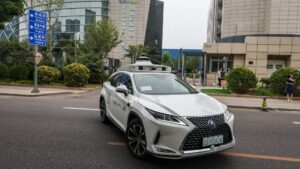The Future of Transportation: Pony.ai’s Revolutionary Step in Robotaxi Services
In an electrifying leap towards autonomous mobility, Pony.ai has captured headlines by becoming the first company in China to earn a permit for charging fares for fully driverless taxis on public roads. This monumental achievement comes at a time when innovative transportation solutions are gaining momentum worldwide, and Pony.ai’s move could set a benchmark for the future of urban mobility.
A Groundbreaking Initiative in Shenzhen
On July 11, 2024, Pony.ai officially unveiled its first robotaxi operations in Shenzhen’s bustling Nanshan district, often referred to as the "Silicon Valley of China." This permit not only places Pony.ai at the forefront of autonomous vehicle development but also highlights Shenzhen as a pivotal tech hub. The permit allows the company to operate entirely driverless taxis—meaning no human staff present—charging fares for rides within a defined area, including key locations like the financial sub-district that houses tech titans such as Tencent and DJI.
Operating Hours and Accessibility
While specific details on the number of vehicles deployed remain under wraps, Pony.ai plans to operate from 7:30 a.m. to 10 p.m. daily. Residents can conveniently book rides through Pony.ai’s mobile application or via a mini-program in WeChat, one of the most popular messaging platforms in China. This integration not only enhances user experience but also reflects the increasing digitalization of transportation services.
Expanding the Robotaxi Network
In addition to its activities in Shenzhen, Pony.ai has made significant strides in other major Chinese cities, including Beijing, Shanghai, and Guangzhou. By late November 2023, the company reported a fleet exceeding 250 robotaxis across the nation. Since 2021, local authorities have allowed Pony.ai—and competitors like Baidu’s Apollo Go—to charge fares for robotaxi services in specific suburban areas of Beijing, emphasizing the regulatory shift towards acceptance of autonomous technologies.
A Balancing Act: Revenue and Growth
While the company reported a notable increase in passenger fares in the fourth quarter compared to the previous year, there was a nearly 61.9% decline in overall revenue from robotaxi services, which dropped to $2.6 million. This dip is attributed to reduced service fees for autonomous vehicle engineering solutions. Conversely, Pony.ai saw a robust 72.7% growth in robotruck services revenue, reaching $12.9 million due to an expansion of its robotruck fleet. This highlights the complexities of the evolving landscape of autonomous mobility, where growth in one sector can offset challenges in another.
The Future is Just a Ride Away
The operational activities of Pony.ai signal a significant turning point not just for transportation in China, but globally. As more cities embrace the technology, the vision of seamless, autonomous travel inches closer to reality. Moreover, as financial trends evolve and these services scale up, the question remains: how will Pony.ai, and its competitors, adapt to harness the full potential of this market?
Join the Conversation
At Extreme Investor Network, we’re dedicated to keeping our readers informed on emerging trends and innovations in finance, technology, and beyond. As the robotaxi landscape continues to evolve, we invite you to engage with us on social media, subscribe to our newsletter, and stay tuned for more insights into the future of investment and innovation. Don’t miss out; the future of transportation is just a ride away!

